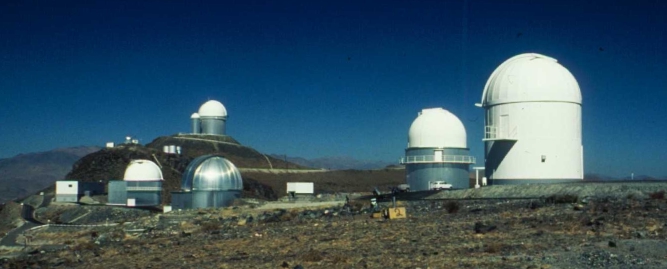
|
About 100 km north of Cerro Tololo (within sight when the lighting is just right), atop Cerro La Silla, are the facilities of ESO, which can nearly match telescope for telescope the facilities operated by both Kitt Peak and Cerro Tololo. First-time observers actually need a map to guide them to the right dome. Forming and maintaining ESO was a major factor in contributing to a specifically European astronomical community, which has made enormous advances culminating in ESO's construction of the 4x8m VLT well to the north at Cerro Paranal. My visits here came when I was on the staff at Leiden Observatory, while Harry van der Laan took every opportunity to try making me a good European. The overall view below shows the astrograph and Danish 1.5m domes in the right foreground, then moves past the 2.2m and 1-m Schmidt domes, sweeping up to the 3.6m (with the characteristic outrigger dome of the coude auxiliary telescope) at the summit itself. The dome just to the lower left of the 3.6m was for the Swiss 60-cm instrument, since replaced at that location by the 3.58-m New Technology Telescope (NTT). This view does not include a cluster of six 0.5-1.5m telescopes behind the viewpoint, nor the 15-meter Swedish/ESO Submillimeter Telescope (SEST) located around the mountaintop past the 3.6m.

|

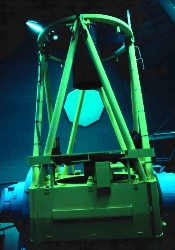 The ESO 3.6m telescope ("el tres-seis") was equipped in the mid-1980s with
a powerful and
flexible imager/spectrograph, EFOSC, which could be used to examine very faint
targets. We turned it to the identification of faint, high-redshift IRAS
galaxies whose IR positions were poorly determined, sometimes using slitless
spectroscopy to identify our quarry before obtaining a more detailed slit
spectrum. This showed clearly which object corresponds to IRAS 0622-645, and
also showed that IRAS 1344-363 is a symbiotic star that managed to masquerade
as a low-redshift Seyfert galaxy on a quick look at the raw data. One more
reason to do the numbers!
The ESO 3.6m telescope ("el tres-seis") was equipped in the mid-1980s with
a powerful and
flexible imager/spectrograph, EFOSC, which could be used to examine very faint
targets. We turned it to the identification of faint, high-redshift IRAS
galaxies whose IR positions were poorly determined, sometimes using slitless
spectroscopy to identify our quarry before obtaining a more detailed slit
spectrum. This showed clearly which object corresponds to IRAS 0622-645, and
also showed that IRAS 1344-363 is a symbiotic star that managed to masquerade
as a low-redshift Seyfert galaxy on a quick look at the raw data. One more
reason to do the numbers!
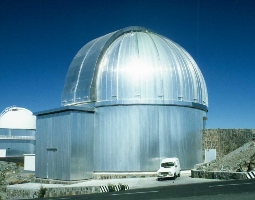
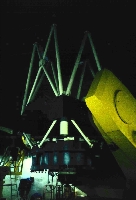 The 2.2m often delivers very good seeing, despite its (traditionally poor)
location in a saddle point on La Silla. Rumor has it that for a while,
ESO would receive proposals asking for 2 nights in the 2.2m or four nights
on the 3.6m. To judge from its control panel, this telescope speaks
German, which made me wonder why the telescope operator made fun of me for
not knowing French. I just asked him to sit in the corner reading his French
novel and keep away from the controls, so we got along fine after that.
I used this instrument (whose control room has the thoughtful addition of a
hot-chocolate dispenser) in part of a search for optical jets in galaxies. This
included an emission-line map of the whole optical jet
of
Centaurus A (NGC 5128),
whose analysis was a real lesson in "do the numbers,
don't just look at the pictures". At first it appeared that the inner knots
were more sharp-edged than the outer ones, but it turns out that they all have
almost exactly the same cross-sectional structure, only differing in size
(so of course the smaller ones look sharper-edged). This changes how one
interprets the pressure balance (or lack thereof) between the visible gas
and surrounding hotter material. Here's a view of the telescope console
when observing Centaurus A:
The 2.2m often delivers very good seeing, despite its (traditionally poor)
location in a saddle point on La Silla. Rumor has it that for a while,
ESO would receive proposals asking for 2 nights in the 2.2m or four nights
on the 3.6m. To judge from its control panel, this telescope speaks
German, which made me wonder why the telescope operator made fun of me for
not knowing French. I just asked him to sit in the corner reading his French
novel and keep away from the controls, so we got along fine after that.
I used this instrument (whose control room has the thoughtful addition of a
hot-chocolate dispenser) in part of a search for optical jets in galaxies. This
included an emission-line map of the whole optical jet
of
Centaurus A (NGC 5128),
whose analysis was a real lesson in "do the numbers,
don't just look at the pictures". At first it appeared that the inner knots
were more sharp-edged than the outer ones, but it turns out that they all have
almost exactly the same cross-sectional structure, only differing in size
(so of course the smaller ones look sharper-edged). This changes how one
interprets the pressure balance (or lack thereof) between the visible gas
and surrounding hotter material. Here's a view of the telescope console
when observing Centaurus A:
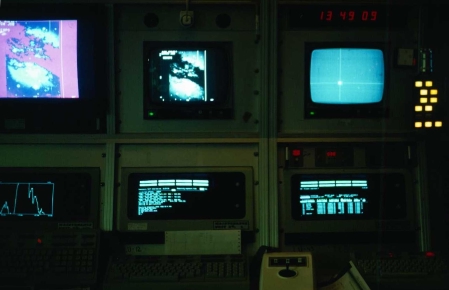
And here's a mosaicked image, rotated by 60°, of some of the Hα filaments along the radio jet of Centaurus A:
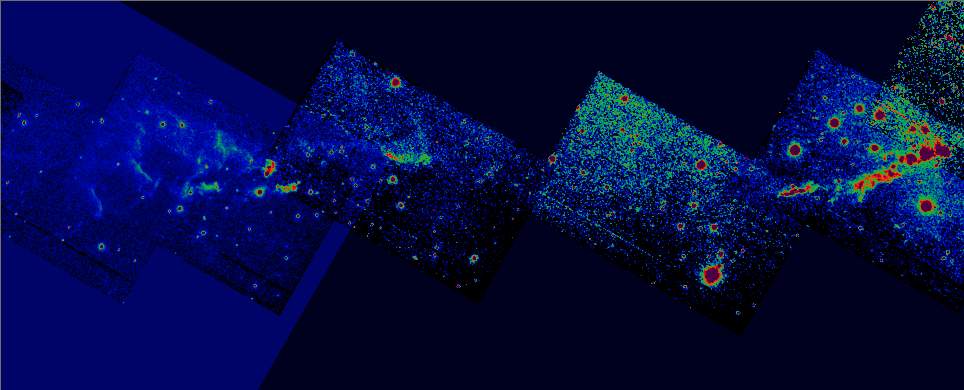
and an especially nice color-composite image of the IR-bright merger NGC 6240:
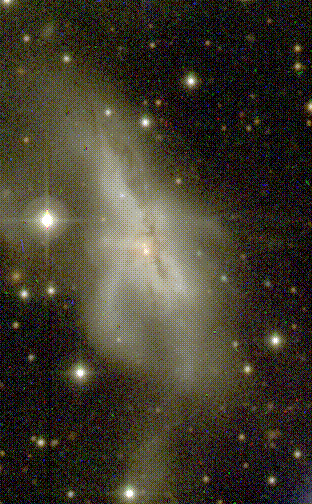
La Silla is also home to the Swedish-ESO Submiillimeter Telescope (SEST), a high-accuracy 15-meter dish which has proven especially valuable in mapping molecular gas in the Magellanic Clouds as well as the southern Galactic plane. It is shown here while still under construction (just after that embarrassing incident involving software limits, the Sun near zenith, and a melted secondary reflector), and against a fog bank after coming into operation a year later.
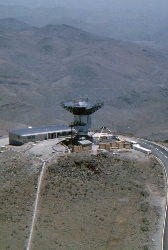 |
 |
Last changes: 4/2007 © 2000-2007